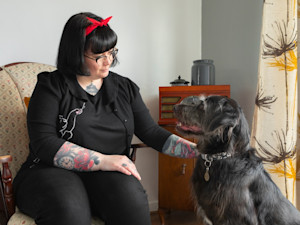How Temporary Dog Fostering Works In the UK
Everything you need to know about fostering dogs in the UK

Share Article
In this article:
What is temporary dog fostering? Benefits of temporary dog fostering Who should use temporary dog fostering? How temporary dog fostering works How to find fostering opportunities How to become a temporary dog foster FAQs
Every year, thousandsopens in new tab of dogs across the UK need foster homes. Whether they’ve been surrendered, found as strays or rescued from unsafe conditions, these dogs depend on temporary care while they wait for adoption.
Foster carers play a vital role. They give dogs a safe, loving environment, easing pressure on overcrowded rescue centres and helping more animals get the second chance they deserve.
Dogs may end up needing foster care for many reasons – their pet parent may be fleeing domestic abuse, suffering with ill health, struggling financially or unable to safely manage the dog around a new baby, for example. Others are sometimes found in dangerous situations, abandoned or may need end-of-life care.
Whatever the reason, when a dog is placed in a loving, temporary home while they await adoption, their life is spared.
“By fostering a dog, you’re saving a life and making a meaningful difference in the world,” says Sharon Williams, Branch Partner and Veterinary Surgeon at Medivet. “You don’t change the world, but you change the world for that dog.”
What is temporary dog fostering?
Temporary dog fostering means giving a dog a safe place to stay when they have nowhere else to go. That could be due to illness, abuse, abandonment or other extenuating circumstances.
Typically, dogs are housed in rescue centres while waiting for adoption. But with rescue centres “full to burstingopens in new tab”, foster carers are essential until long term placementsopens in new tab are found.
“We have a little group of fosterers we draw on when there is an animal at risk,” Sharon says. “When there is an animal at risk, we contact our fosterers who we think might be suitable to have the dogs.”
Placement lengths vary. Some last days, others can stretch into months. Occasionally, carers commit to keeping the dog long-term.
“The fosterer looks after the dog as if they’re the fosterer’s own,” she continues, adding that rescue centres cover expenses while the dogs are being looked after by foster carers.
Some dogs come from pounds, where strays are kept for just seven days. If not claimed or rehomed by then, they risk being put to sleep. “We have ‘pound pullers’ – people who monitor pounds and post dogs on rescue Facebook groups to try and find places for them,” Sharon explains.
If rescue centres and pounds can’t find anyone to take the dogs, there comes a point when the dog will have to be euthanised. “If there is no space for the dog to go – they’ll be put down,” she says.
Some rescue centres, like the one Sharon works at, never put dogs to sleep, but there are many who have no choice.
Once a rescue centre has found a suitable adoptive family for the dog, the foster carer’s job is done. “But quite often, the foster carer decides they want to keep the dog,” she says. “Which is why we always need more fosterers, because we lose them to the dogs – in the best possible way.”
Benefits of temporary dog fostering
For the dogs:
Some dogs struggle in rescue centre kennels, stressed by the high level of noise, leading to weight loss or behavioural issues.
“We always try to get dogs that stress easily in with foster carers – it is just a nicer experience for them,” says Sharon.
Oftentimes, by spending time in foster care rather than kennels, dogs become more adoptable. With their needs met, they’re often calmer. Foster carers also might train a dog while they are staying with them.
When foster carers take dogs in, they are also making space for more dogs to be rescued by centres, and “more dog lives are saved”, says Sharon.
For the foster carer:
By taking over the short-term care of dogs, foster carers can know they are helping dogs and saving lives.
“It’s rewarding, and can give someone a purpose in life,” says Sharon.
Others use fostering as a way to gauge whether they could take a dog long-term, says Sharon. It’s a bit like a practice round to see if they can handle a bigger commitment.
Other fosterers lifestyles aren’t always suitable for having a dog full-time, but fostering gives them the pleasure of having a dog temporarily. They get the joy of a dog, a best friend, without the commitment.
Who should use temporary dog fostering?
In cases where a dog can no longer live with their pet parent, temporary dog fostering presents a compassionate solution, keeping the dog both alive and well-taken care of.
For people who want to help dogs in need, but can’t commit to long-term adoption, fostering is a great option. All the pleasure of having a dog, with lots of support from a rescue centre, but no long-term commitment.
Most foster carers need to be at least 18 years old, have regular access to outside space and be close to the rescue centre they’ve volunteered through. In a lot of cases, it is advised that the dog fostered lives in a household without children or other dogs.
How temporary dog fostering works
When a dog is surrendered or rescued, rescue centres house them while looking for a match. But to make space and give dogs a more homely setting, they also rely on foster carers.
Rescue centres will either directly contact suitable foster carers who have previously applied or make appeals online for new foster carers in cases where none are available. If you’ve applied before, the centre might contact you directly about a dog. If not, they’ll post appeals online for urgent placements.
Most rescue centres will do a home check and interview of the applicant to ensure the placement is appropriate for both the dog and the foster carer.
The time a person fosters varies depending on the individual dog and situation. It could be a day, simply taking the dog on a long walk, or last for months, even years. Discussion about expectationsopens in new tab for length of stay will happen when the rescue centre makes contact.
While it isn’t ideal to move dogs around from placement to placement – centres aim to keep dogs in one stable foster home where possible – but even short-term help is hugely valuable.
While the dog is with you, you’ll be financially supported and contacted regularly by the rescue centre’s team, who can help with anything that is needed.
You’ll walk, feed, train and look after the dog like they’re your own – and in return, you’ll get tail wags, affection and the satisfaction of knowing you’re making a real difference.
How to find temporary dog fostering opportunities
There are a number of charities and rescue centres that welcome applications from new foster carers. The RSPCA, Dogs Trust, and Blue Cross are some of the bigger charities crying out for volunteer foster homes. But there are smaller charities that might be more local to you. Just give them a ring or an email to arrange to chat and apply.
How to become a temporary dog foster
Once you’ve applied as a temporary dog fosterer, you’ll be contacted by the rescue centre or charity to chat. They’ll typically arrange a home visit to check suitability once they’ve found a dog they’d like you to foster. Finally, you’ll get to take your new friend home until they’re adopted.
Responsibilities of a temporary dog foster
A dog fosterer will be responsible for doing everything that an owner would – feeding, snuggling, walking, grooming and vet visits. In cases where the dog needs training, this would be fully discussed before you agree to take the dog home. Rescue centres can even arrange transport if a fosterer doesn’t have access to a car.
Support and resources for dog fosters
Rescue centres will cover the cost of the dog while they’re in your care – from food to vet bills – but they will also offer support. At Sharon’s rescue centre, foster carers can join a WhatsApp group to chat with their team when questions or concerns arise, for example.
Bottom line: temporary dog fostering in the UK
When someone volunteers to temporarily foster a dog, they are relieving pressure on shelters (allowing for more dogs to be rescued), providing a loving environment for a vulnerable animal, supporting people in crisis who can no longer care for their pets and increasing the chance of long-term adoption.
As a huge plus, fosterers also experience the joy of having a dog – with all the pleasure and companionship they bring – without the long-term commitment.
Frequently asked questions
What is the temporary dog fostering service?
Temporary dog fostering is when volunteers offer short-term homes to dogs who can’t stay with their pet parents or are waiting to be adopted. It gives dogs a safe, loving environment outside of a rescue centre and helps shelters free up space to take in more animals. Most rescue centres and charities run fostering services, matching each dog with a suitable carer and covering the costs during their stay.
Who is eligible for temporary dog foster care?
Eligibility requirements for temporary fosterers is dependent on the needs of the dog.
“Hopefully, they’d have prior experience of handling dogs, but not always,” says Sharon. “Some dogs will need a pet-free home. Some will need a child-free home. Some dogs might need a strong person.”
Generally, foster carers need to be over 18, have a suitable home environment – ideally with access to a garden or walking space, be available to help the dog feel comfortable, have permission from a landlord if renting, and be available to take the dog to any appointments it may have. Some dogs may require a pet or child-free household.
What is the shortest time you can foster a dog?
Rescue centres need volunteers who might only be able to volunteer a day, right through to volunteers who can give years. Even if you’re only able to foster a dog for a short time, you’ll have changed a life.

Lauren Crosby Medlicott
Lauren is a freelance journalist who lives with her family and black labrador, Betsie, in the south Wales valleys. When she’s not working, she loves going for a dip in a nearby river and hiking in the Brecon Beacons.
Related articles

The Dog Fostering Lifeline Helping People Flee Domestic Abuse
Beloved pets are often used by perpetrators of domestic abuse to manipulate their victims. That’s why Dogs Trust runs a specialist service to temporarily home dogs while their parents seek safety

Why You Should Adopt a ‘Less Adoptable’ Dog
Why you shouldn’t rule out senior dogs, special-needs pups, bully breeds or tripods

5 People Who Found Lasting Love With So-Called ‘Difficult’ Dogs Who Survived Trauma
“She senses my needs like I sense hers. I don’t know who I am without her.”

How to Prepare For an Adoption Home Visit
7 tips for acing your inspection and bringing your new pup home
